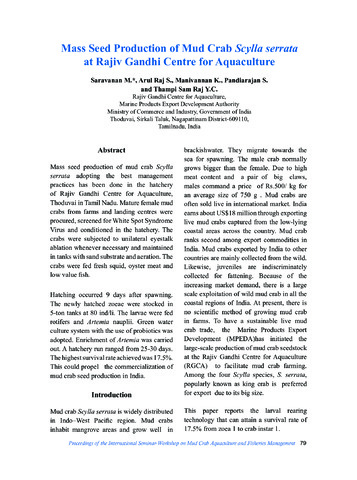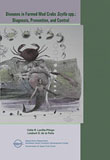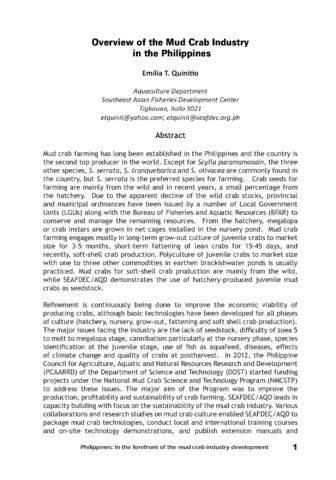Mass seed production of mud crab Scylla serrata at Rajiv Gandhi Centre for Aquaculture
- Global styles
- MLA
- Vancouver
- Elsevier - Harvard
- APA
- Help

View/Open
Date
2015Page views
6,348ASFA keyword
AGROVOC keyword
Taxonomic term
Metadata
Perlihat publikasi penuhShare
Abstract
Mass seed production of mud crab Scylla serrata adopting the best management practices has been done in the hatchery of Rajiv Gandhi Centre for Aquaculture, Thoduvai in Tamil Nadu. Mature female mud crabs from farms and landing centres were procured, screened for White Spot Syndrome Virus and conditioned in the hatchery. The crabs were subjected to unilateral eyestalk ablation whenever necessary and maintained in tanks with sand substrate and aeration. The crabs were fed fresh squid, oyster meat and low value fish.Hatching occurred 9 days after spawning. The newly hatched zoeae were stocked in 5-ton tanks at 80 ind/li. The larvae were fed rotifers and Artemia nauplii. Green water culture system with the use of probiotics was adopted. Enrichment of Artemia was carried out. A hatchery run ranged from 25-30 days. The highest survival rate achieved was 17.5%. This could propel the commercialization of mud crab seed production in India.
Suggested Citation
Saravanan, M., Arul Raj, S., Manivannan, K., Pandiarajan, S., & Thampi Sam Raj, Y. C. (2015). Mass seed production of mud crab Scylla serrata at Rajiv Gandhi Centre for Aquaculture. In E. T. Quinitio, F. D. Parado-Estepa, Y. C. Thampi Sam Raj, & A. Mandal (Eds.), Proceedings of the International Seminar-Workshop on Mud Crab Aquaculture and Fisheries Management, 10-12 April 2013, Tamil Nadu, India (pp. 79-83). Tamil Nadu, India: Rajiv Gandhi Centre for Aquaculture (MPEDA).
Type
Conference paperISBN
9788192989815
Related items
Showing items related by title, author, creator and subject.
-
Larval rearing of mud crab (Scylla): What lies ahead
Waiho, Khor; Fazhan, Hanafiah; Quinitio, Emilia T. ; Baylon, Juliana C.; Fujaya, Yushinta; Azmie, Ghazali; Wu, Qingyang; Shi, Xi; Ikhwanuddin, Mhd; Ma, Hongyu (Elsevier, 2018)
The increasing global demand for mud crabs (genus Scylla) and threats to the wild populations highlight the urgency of fully rearing them in captivity. Despite considerable progress in mud crab production, most crab farms ...
; Baylon, Juliana C.; Fujaya, Yushinta; Azmie, Ghazali; Wu, Qingyang; Shi, Xi; Ikhwanuddin, Mhd; Ma, Hongyu (Elsevier, 2018)
The increasing global demand for mud crabs (genus Scylla) and threats to the wild populations highlight the urgency of fully rearing them in captivity. Despite considerable progress in mud crab production, most crab farms ...
-
Diseases in farmed mud crabs Scylla spp.: Diagnosis, prevention, and control.
Lavilla-Pitogo, Celia R.; de la Peña, Leobert D. (Aquaculture Dept., Southeast Asian Fisheries Development Center, 2004-12)Aquaculture production has suffered many set-backs due to the occurrence of diseases. Many of the diseases are caused by infectious organisms that are difficult to detect and need sophisticated instruments for diagnosis, ... -
Overview of the mud crab industry in the Philippines
Mud crab farming has long been established in the Philippines and the country is the second top producer in the world. Except for Scylla paramamosain, the three other species, S. serrata, S. tranquebarica and S. olivacea ...





